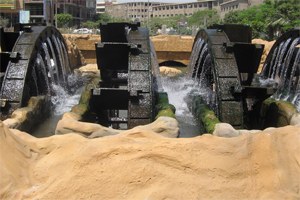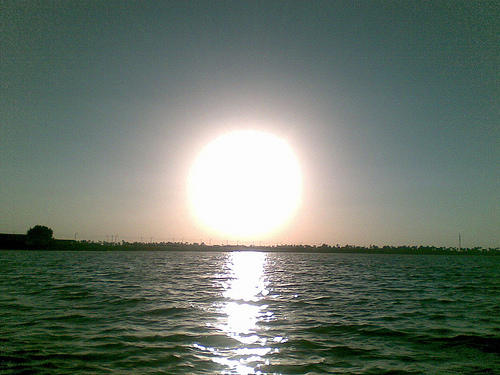El Fayoum

The National Day
Fayoum celebrates its national day on the fifteenth of March(15-3) every year. This day is the memory of resisting the English occupation during the 1919 revolution. This day comes in the beginning of the spring when nature is perfect in Fayoum.
|
|
|
|
El Fayum is one of the governorates in the north-west of Egypt about 100km from Cairo . El Fayum is renowned for its fertile land , fascinating tourist attractions that date back to ancient Egyptian time and its great history .
The name of "El Fayum" comes from the Coptic word 'Phiom' , which means lake or sea since it was enclosing a sea in the Prehistoric period . Ptolemy II (Philadelophos) gave El Fayoum the name 'Philadelphia' . El Fauoum is also renowned for its Fayimian and Meorian Cultures that date back to the 5500 to 4000 BC . People of these cultures were sedentary and knew methods of agriculture and pottery making . With the climatic changes , around 4000 BC people began to abandon Fayoum and migrate to the Nile Valley , getting in contact with the people of Maadi Culture . However , El Fayoum remained a savage site for hunting and extracting mining salts . Thus , the Ancient Egyptians identified the lake of El Fayoum with some appropriate names , such as 'the Nun' or the Primeval Ocean , where life began . El Fayoum was the cult of Sobek god , the crocodile , and the lake of El Fayoum was regarded as a sacred place In the Old Kingdom and some temples were established for worshiping him .
In the Middle Kingdom the region of El Fayoum witnessed a great prosperity and a large number of temples were established . King Amen-Em-Hat (of the Twelfth Dynasty) chose the site of Lisht , on the midway between the Nile Valley and Fayoum , to be his residence . Amen-Em-Hat I built his pyramid there and it is thought also that he flooded Fayoum to create the Lake Moeris . During this dynasty , the whole region witnessed a wide scale development . El Lahun Pyramid , the colossi of Biahmu , the Labyrinth Pyramid all belong to this period .
During the Greek Period , the region prospered once again and hundreds of papyri found in different cemeteries of Fayoum provide much information on the booming life the Fayoumians led . But once the region began to decline by the 2nd century , it was gradually abandoned .
There are other monuments in El Fayoum including the famous for Karoun Lake and the Valley of Whales , with more than 500 skeletons of whales that are most popular tourist attractions in Egypt . Immersing in a plane view of the scene of the desert , one enjoys seeing a number of valleys , which once were rivers and lakes . In old times , people used to dwell there more than in the Nile Valley .
In addition to Lakes , tourist attractions El Fayum has become one of the major agricultural lands in Egypt that is rich in is regarded thanks to the improvement of communicational means , irrigation methods and investment in diverse crops .
The name of "El Fayum" comes from the Coptic word 'Phiom' , which means lake or sea since it was enclosing a sea in the Prehistoric period . Ptolemy II (Philadelophos) gave El Fayoum the name 'Philadelphia' . El Fauoum is also renowned for its Fayimian and Meorian Cultures that date back to the 5500 to 4000 BC . People of these cultures were sedentary and knew methods of agriculture and pottery making . With the climatic changes , around 4000 BC people began to abandon Fayoum and migrate to the Nile Valley , getting in contact with the people of Maadi Culture . However , El Fayoum remained a savage site for hunting and extracting mining salts . Thus , the Ancient Egyptians identified the lake of El Fayoum with some appropriate names , such as 'the Nun' or the Primeval Ocean , where life began . El Fayoum was the cult of Sobek god , the crocodile , and the lake of El Fayoum was regarded as a sacred place In the Old Kingdom and some temples were established for worshiping him .
In the Middle Kingdom the region of El Fayoum witnessed a great prosperity and a large number of temples were established . King Amen-Em-Hat (of the Twelfth Dynasty) chose the site of Lisht , on the midway between the Nile Valley and Fayoum , to be his residence . Amen-Em-Hat I built his pyramid there and it is thought also that he flooded Fayoum to create the Lake Moeris . During this dynasty , the whole region witnessed a wide scale development . El Lahun Pyramid , the colossi of Biahmu , the Labyrinth Pyramid all belong to this period .
During the Greek Period , the region prospered once again and hundreds of papyri found in different cemeteries of Fayoum provide much information on the booming life the Fayoumians led . But once the region began to decline by the 2nd century , it was gradually abandoned .
There are other monuments in El Fayoum including the famous for Karoun Lake and the Valley of Whales , with more than 500 skeletons of whales that are most popular tourist attractions in Egypt . Immersing in a plane view of the scene of the desert , one enjoys seeing a number of valleys , which once were rivers and lakes . In old times , people used to dwell there more than in the Nile Valley .
In addition to Lakes , tourist attractions El Fayum has become one of the major agricultural lands in Egypt that is rich in is regarded thanks to the improvement of communicational means , irrigation methods and investment in diverse crops .

 1:19 PM
1:19 PM
 Egypt
Egypt






0 comments:
Post a Comment